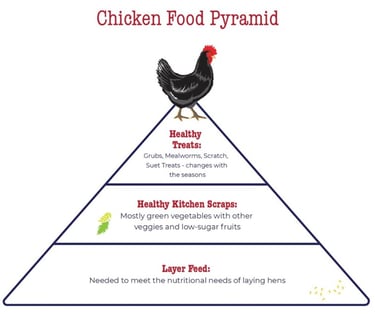Flock Management 101: What Should I Feed My Chickens?
by Lesa Wronski, CVT RVT
10/12/20255 min read


Image from https://backyardpoultry.iamcountryside.com/
As responsible chicken keepers, we want to be assured that we are doing our best for our birds, and having a good nutritional plan is a major part of good flock management. Above is a food pyramid that is a good visual to help determine what and how much you should feed. For chickens under 20 weeks of age, you want to substitute a starter/grower feed for the layer feed, but even young chicks can use this as long as they are small bites, and you provide grit for them.
As you can see in the pyramid, the main part of the diet is going to be a balanced feed of some sort. This should make up the majority of your flock’s diet and should also be provided even if your chickens free-range in order to assure they always have access to balanced nutrition. Free-ranging does provide wonderful stimulus for your birds, and will really help supplement their diet, but in most cases, especially if they aren’t able to free-range a very large acreage, it is not going to be enough to provide optimal nutritional needs.
Let’s start with chicks and young chickens up to 20 weeks of age. These birds should be started on a good quality commercial feed such as Eden Feeds Non-GMO Chick Starter – Grower 19%.
Commercial feeds are formulated to provide all the nutrients a growing chick needs. There’s no guesswork. They contain the proper amount and ratio of proteins, vitamins and minerals needed to grow into a healthy adult. Chicks have different nutritional needs than adult chickens, and feeding a high-quality commercial feed assures you are meeting those requirements. Starter-grower also feeds have been ground into finer pieces that makes it easier for the chicks to eat the feed and digest it. You should also be offering chick-sized grit at this time, even if the feed contains grit, to allow your chicks to start regulating their grit intake on their own. I start my chicks on chick grit the moment I put them into the brooder so I know they are going to be able to get what they need to be able to digest their feed.
Once your chickens have grown into young adults, after 20 weeks or so, they should be switched to a layer feed as once again, their nutritional requirements will have changed. They are now either laying eggs, or are ramping up to lay eggs, and laying is hard and takes a lot of energy and resources from your chickens. Egg production requires your birds to continuously have to replace protein and calcium, and a good feed like Eden Feeds Non-GMO Layer Mash 17% is going to provide this. At this point, they should also always have a calcium supplement available, and larger-sized grit.
If you have cockerels and/or roosters in your flock, many people will say that instead of feeding a layer feed, you should feed an all-flock, as there is too much calcium in a layer feed and it could cause problems for your male birds because they do not need the extra calcium for egg production. My thoughts on this are that there is that there is a much higher risk of causing problems with your pullets and hens if they do not get enough calcium in their diet than there is of causing issues with your roosters, so I would just feed the layer feed. Do your own research and decide what is best for your flock.
Now, you are going to see brands out there that offer pelleted and crumbled feed. Understand that these feeds are highly processed. They are made from grains that all ground together, steamed to add moisture and basically “cook” everything, then dried and extruded into pellets or crumbles. As with all foods, adding heat to something does strip out nutrients, and so extra vitamins and minerals are added. And while this is perfectly adequate nutrition for your birds, I feel it is always better to feed foods that have not been overly processed the way these feeds have been. It’s like the difference between a can of soup you open and add water to versus soup you make from fresh ingredients. The fresh one is usually better for you and you know exactly what you put into it.
I do want to address the “chickens are basically garbage disposals” idea. They are not and should not be treated as such. Sure, they can have scraps from your kitchen, but you should be mindful of what you are offering them, and scraps should not be the bulk of their diet. Fast foods, foods high in processed sugars and fats…your chickens should never have these. It’s simply not good for them. Fatty foods can lead to fatty liver in chickens and that can kill them. Will they eat foods that aren’t good for them, of course, because they taste good. There are so many things you can give to them that are actually good for them, and fatty, sugary foods should not be on that list. Remember: garbage in, garbage out. You want to give your chickens the best nutrition possible so they can give you the best eggs and meat, and continue to do so without it affecting their health. A benefit of feeding good scraps to your birds means that you and your family are also eating better as well. It’s really a win-win.
That’s not to say your chickens can’t have treats. They can, and giving treats helps them to bond with you. Offer healthy treats. If you want to add protein, offer mealworms or dried black soldier fly larva (BSFL)…and pay attention to where these are sourced. There’s a lot of cheap BSFL out there on various places like Amazon, but where are these coming from? Are they imported? What were these insects fed? I personally will pay a little more for BSFL that I know were not imported from another country that might not have good food practices, and I have found my chickens like them more, too.
A feeding guideline is ½ cup of BSFL split between 6 chickens per day.
Fruits and veggies are good, healthy treats. If you feed fruits, do it in moderation as they usually contain a lot of sugar, and some fruits can lead to runny poops, which is messy considering how often chickens poop. Veggies are always a great treat, but as with fruit: moderation.
Some other considerations would be during molting and really hot temps: your girls will need more protein during these times so be sure to make sure you are giving them some. It can be BSF larva or it can be scrambled eggs (just hold the butter). You can also feed a higher protein commercial diet during these stressors, too.
Finally, feed your girls the best quality food you can afford to feed them. There’s no judgement here. If you can’t afford the super boutique bag of commercial feed, other commercial feeds are still going to give them the nutritional basics of what they need, but there will definitely be differences in quality of ingredients, the ingredients may be imported from other countries, and the feed will more than likely be made up of larger amounts of fillers such as corn. Do remember that while you “get what you pay for” is true, sometimes a large amount of what you are actually paying for is just brand-recognition and advertising. That’s another reason I really love and recommend Eden Feeds, they provide a great quality, non-GMO feed without fillers at a really affordable price point. It’s quality nutrition for your girls without breaking the bank.
About the author: Lesa is registered veterinary technician and crazy chicken lady who is passionate about educating and advocating for the humane and best practices care for animals. She is the Head Hen of The Bougie Coop, a podcast about keeping chickens in urban and suburban small spaces. It is available on Apple Podcasts, Spotify, and Amazon Music.

